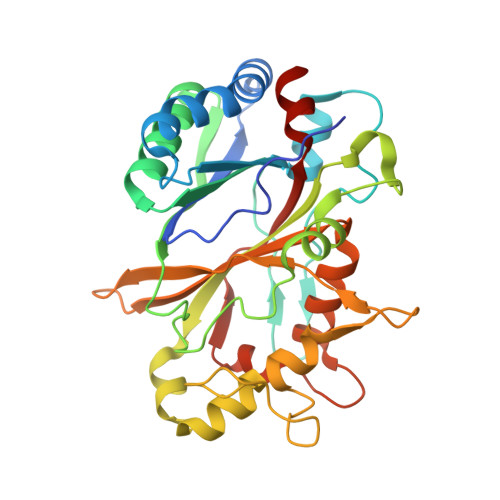Serial Femtosecond Zero Dose Crystallography Captures a Water-Free Distal Heme Site in a Dye-Decolorising Peroxidase to Reveal a Catalytic Role for an Arginine in Fe IV =O Formation.
Lucic, M., Svistunenko, D.A., Wilson, M.T., Chaplin, A.K., Davy, B., Ebrahim, A., Axford, D., Tosha, T., Sugimoto, H., Owada, S., Dworkowski, F.S.N., Tews, I., Owen, R.L., Hough, M.A., Worrall, J.A.R.(2020) Angew Chem Int Ed Engl 59: 21656-21662
- PubMed: 32780931
- DOI: https://doi.org/10.1002/anie.202008622
- Primary Citation of Related Structures:
6YR4, 6YRC, 6YRD, 6YRJ - PubMed Abstract:
Obtaining structures of intact redox states of metal centers derived from zero dose X-ray crystallography can advance our mechanistic understanding of metalloenzymes. In dye-decolorising heme peroxidases (DyPs), controversy exists regarding the mechanistic role of the distal heme residues aspartate and arginine in the heterolysis of peroxide to form the catalytic intermediate compound I (Fe IV =O and a porphyrin cation radical). Using serial femtosecond X-ray crystallography (SFX), we have determined the pristine structures of the Fe III and Fe IV =O redox states of a B-type DyP. These structures reveal a water-free distal heme site that, together with the presence of an asparagine, imply the use of the distal arginine as a catalytic base. A combination of mutagenesis and kinetic studies corroborate such a role. Our SFX approach thus provides unique insight into how the distal heme site of DyPs can be tuned to select aspartate or arginine for the rate enhancement of peroxide heterolysis.
- School of Life Sciences, University of Essex, Wivenhoe Park, Colchester, Essex, CO4 3SQ, UK.
Organizational Affiliation:




















